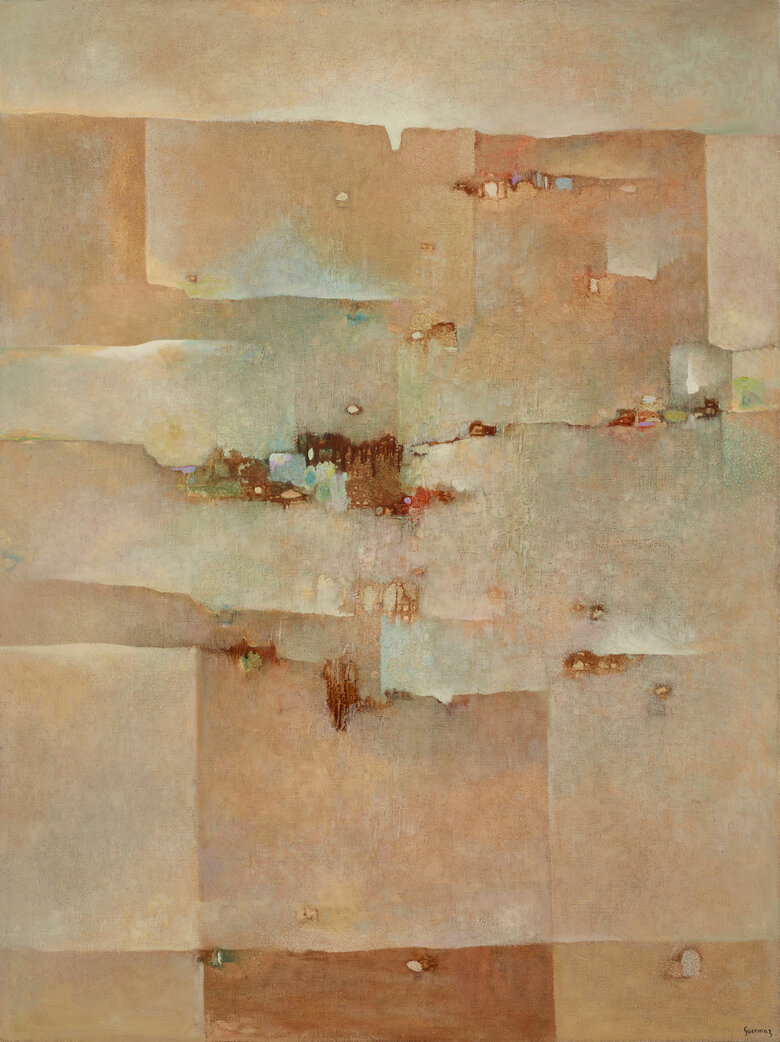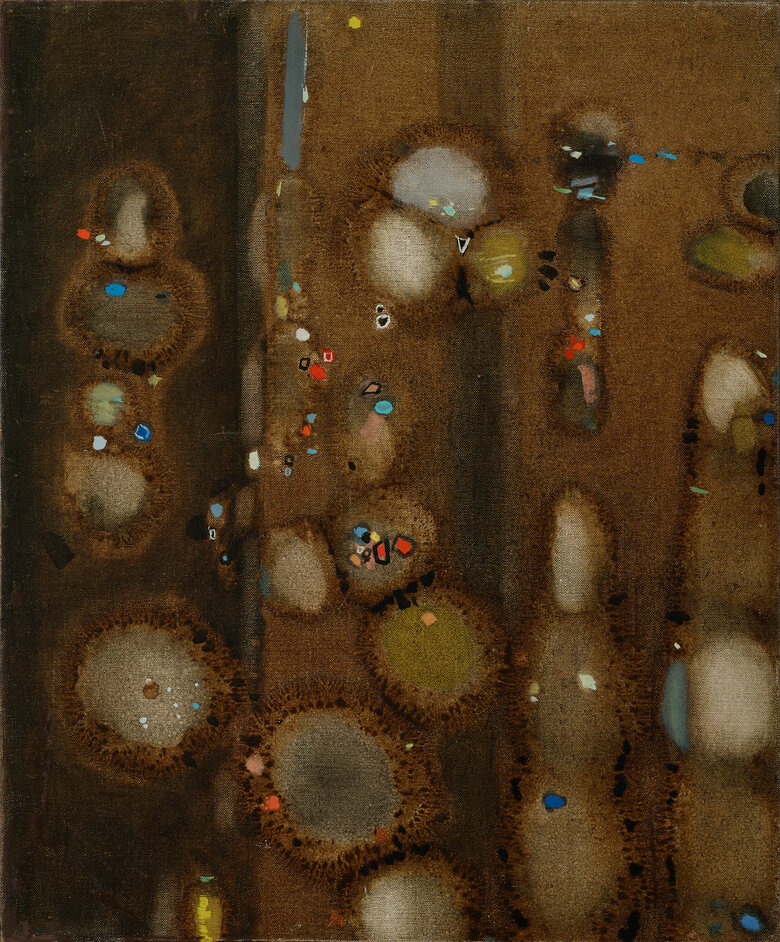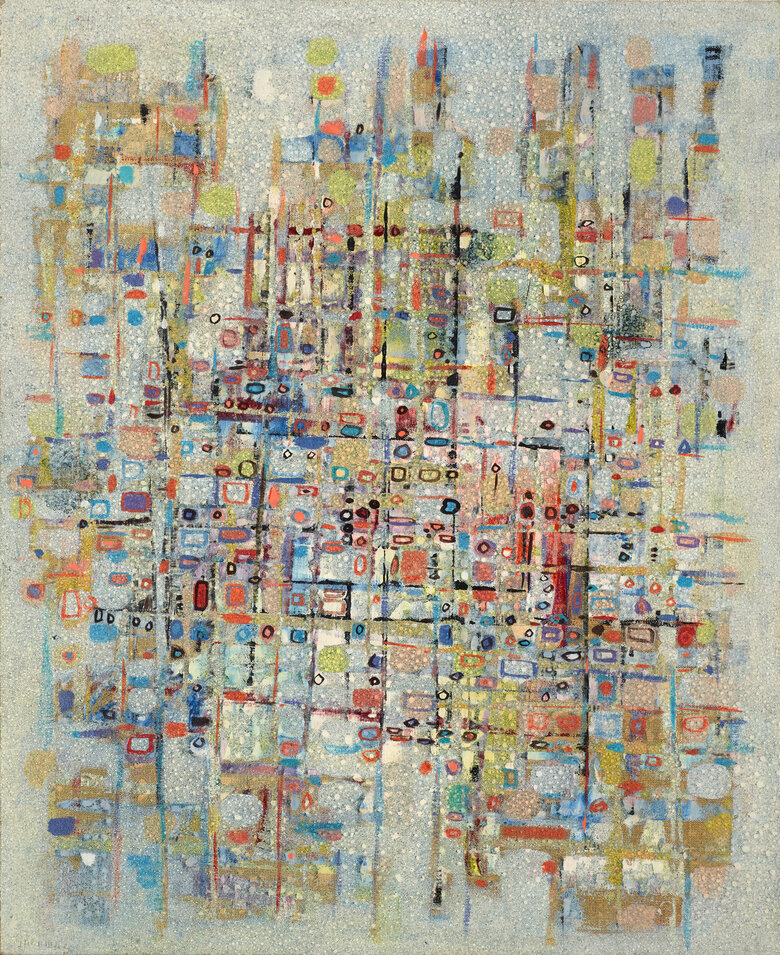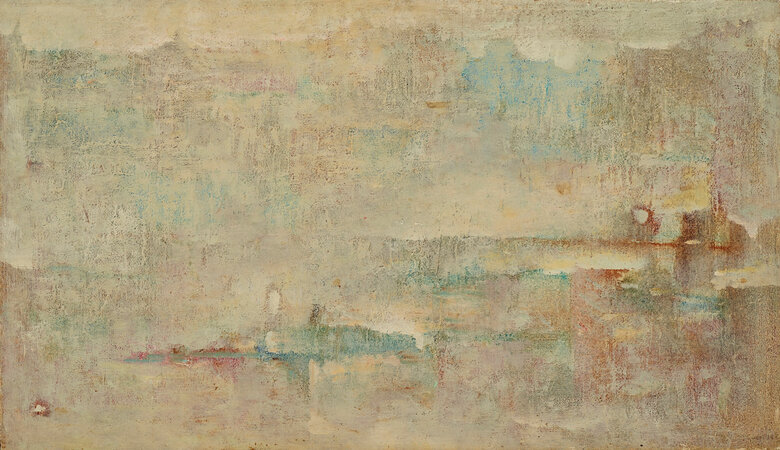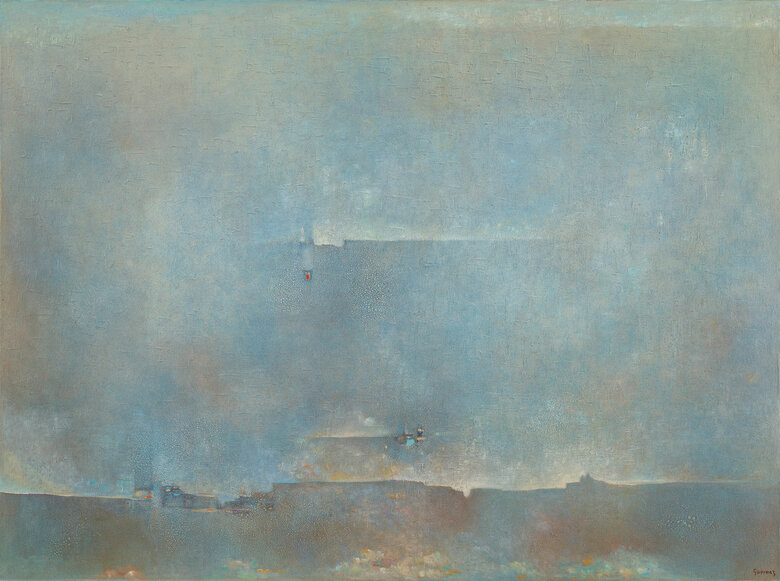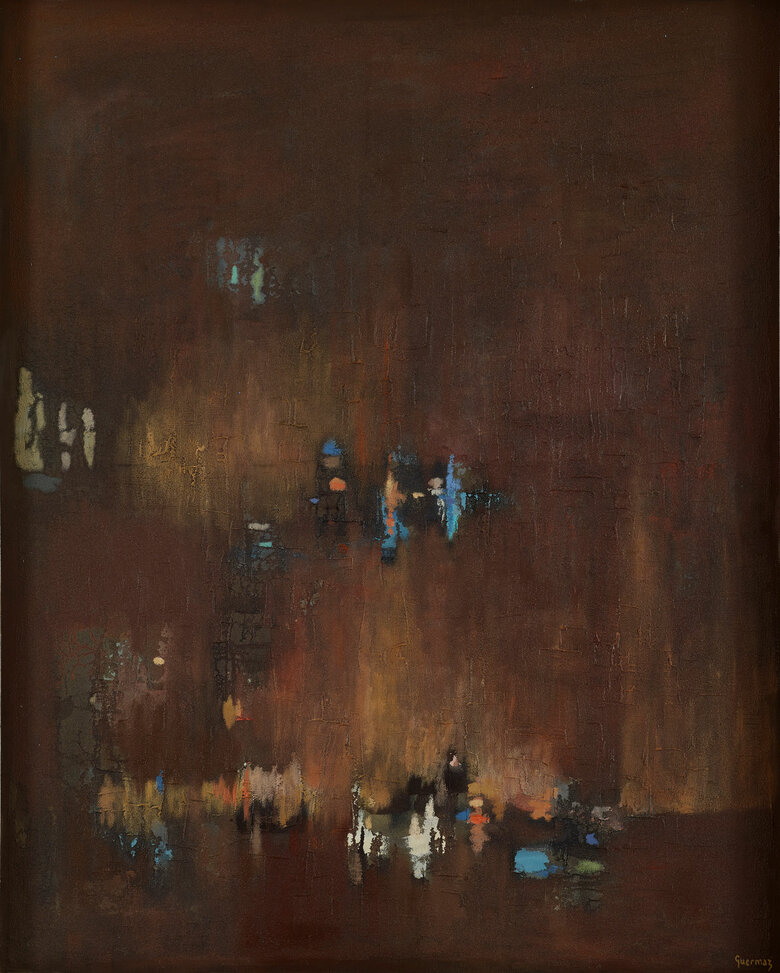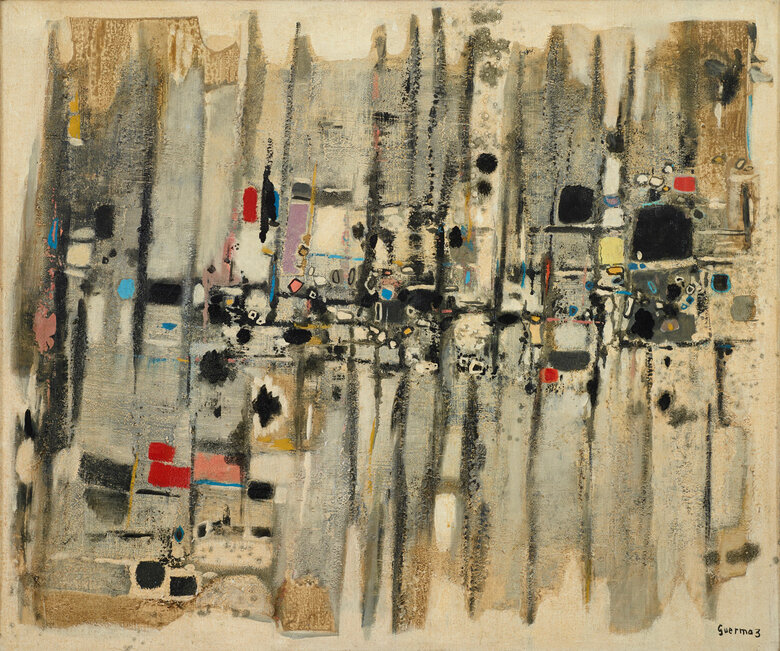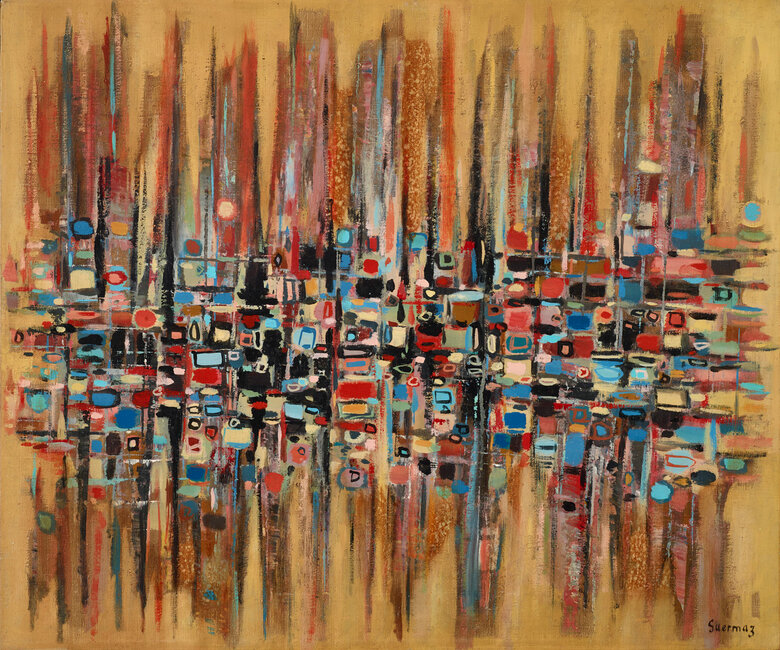Born in 1919 in the city of Mascara, in northwestern Algeria, Abdelkader Guermaz came from a modest farm family. After losing his father in 1929, Guermaz relocated with his mother to Oran, where...

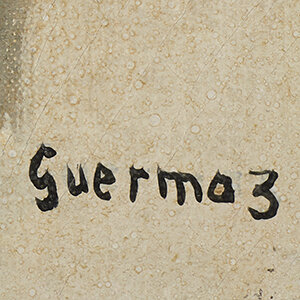
ABDELKADER GUERMAZ, Algeria (1919 - 1996)
Bio
Written by ARTHUR DEBSI
Born in 1919 in the city of Mascara, in northwestern Algeria, Abdelkader Guermaz came from a modest farm family. After losing his father in 1929, Guermaz relocated with his mother to Oran, where he spent his entire childhood. During the 1930s, Oran was a dynamic cultural center of West Algeria, and was described as an enjoyable cosmopolitan city, where some Spanish painters settled as political exiles, bringing with them new artistic concepts[1]. The city included prestigious institutions, dated from the French occupation, such as museums, the Galerie Colline, as well as the École des Beaux-Arts in Oran, opened in 1936, and directed by the French orientalist painter Augustin Ferrando (1880-1957) from 1919 to 1928. The Algerian painter Abdallah Benanteur (1931-1917) was the most familiar with Abdelkader Guermaz, whose private life remains unknown. He especially recalled that this vibrant environment impacted the young Abdelkader Guermaz[2], who had shown an early interest in arts. He was into literature, painting and music – he assiduously practiced piano for five years. He consequently refused to pursue a ‘serious’ career, and preferred to fulfill his own aspirations as an artist.
In 1937, Abdelkader Guermaz enrolled at the École des Beaux-Arts in Oran – being the only Algerian student back then, showing great skills in drawing. Three years later, he went to Algiers, where he studied Arab miniature, and illuminations with the Algerian painter Mohammed Racim (1896-1975). This experience introduced Guermaz to the arts of Islam for the first time, as he had only followed a European academic curriculum before. Yet, he would quickly come back to Oran. It is important to notice that, contrary to some artists of his generation such as Mohamed Issiakhem (1928-1985), and Mohammed Khadda (1930-1991), Abdelkader Guermaz stayed in Algeria during the 1940s, and 1950s. As a matter of fact, he started a collaboration, which would span over twenty years, with the French gallerist Robert Martin (1915-2002), established in Oran. The latter was an imminent figure in the cultural scene, and ran the Galerie Colline, that he founded in 1941. The art space was an important meeting place, which exhibited works from local, and Parisian modern artists including Henri Matisse (1869-1954), and Pablo Picasso (1881-1973). As of the opening of the gallery, Guermaz was able to participate in collective exhibitions, attracting young Algerian artists, who saw him as a pioneer in Algerian art, as Benanteur remembered: ‘Il a été important pour nous. Il était miraculeux de voir un Algérien faire de la peinture et l’exposer’[3].
At that time, Abdelkader Guermaz lived in poverty, and this collaboration with the Galerie Colline, enabled him to survive. He would regularly give the gallery a painting, while receiving a monthly stipend. In 1960, he traveled to France on a scholarship provided by the gallery, and settled in Paris, where he frequented the vivid artistic neighborhoods of Montmartre, and Montparnasse. There, he produced caricatures for living, simultaneously attending drawing courses at the Académie de la Grande Chaumière.
Among the first Algerian artists graduated from the École des Beaux-Arts in Oran in 1940, Abdelkader Guermaz was offered a position as teacher of painting at the same institution. First, he accepted, but after careful consideration, he resigned before the semester started saying that he didn’t want to stay in the academic world, already considering himself as an avant-garde painter[4].
In the 1960s, Abdelkader Guermaz highly manifested his adoption to abstraction through the works, that he produced during his time in Paris. In an interview conducted in 1968, he confessed: ‘Je me suis libéré peu à peu des formules apprises aux Beaux-Arts, et je suis devenu progressivement abstrait (…)’[5]. The oeuvre of Guermaz is effectively related to the elaboration of abstract art in France, but also in Algeria. In the 1950s, he was one of the first painters to adhere to the abstract movement in his home country, being inspired by the artworks of Parisian painters. For him, and other Algerian artists, abstraction was a form of expression, which somehow corresponded to the process of re-appropriating a local culture. In fact, they came to understand, that abstraction was part of their own artistic identity, either Arab, Kabyle, or Islamic; that they could take to elaborate modern Algerian art.
The first stage of Abdelkader Guermaz’s oeuvre was inherent to the lyrical abstraction. In France, he was considered to be part of this movement from the ‘nouvelle École de Paris’ (Second School of Paris), which gathered realistic figurative artists, as well as abstract artists[6]. The movement encouraged the artists to directly express their emotions on the canvas; and this artistic approach in Guermaz’s works was certainly due to his encounters with abstract paintings, that he contemplated in galleries in Paris. Since then, he considered painting to be the ground, where he could express his inner world in connection with the external world. From the 1960s, the Dalloul Art Foundation’s collection includes few paintings, which reveal the considerable reflection of the artist, and his experimentations on abstract art. Abdelkader Guermaz worked on a specific plastic treatment, which was about a peculiar use of colors, and the structure of the composition. As he stated: ‘L’objet ne m’intéresse pas tel qu’il est. Je le désintègre pour ne m’intéresser qu’au rythme et à la recherche des nuances’[7]. Since he studied at the École des Beaux-Arts in Oran, Guermaz had always been interested in meticulously preparing the canvas. Before painting it, he conceived it as a wall, whose the ideal color is white, and with which he could play with the material. In the work Arabesque de C.Debussy (1963), dated from his early years in the French capital city, he applied a palette, with cool colors, and small touches of warm colors like red, and yellow, that he juxtaposed on a light background. To add some structure to the abstract composition, Guermaz employed the black color, with which he drew a grid in the middle of the painting. Here, the artist rendered the vibrations of the colors, and gave the ensemble a very poetic aspect. The title of the painting refers to the famous French music composer (1862-1918), who was a significant source of inspiration for the artist. Abdelkader Guermaz was convinced that music, and art shared the common point of unity, and harmony, which are a seminal notion in his entire oeuvre[8].
The oeuvre of Abdelkader Guermaz always stayed inherent to lyric abstraction. However, as of the 1970s, the painter moved towards a more mystical work, like many of artists at the time, but also poets, and writers from the Maghreb countries[9]. In 1972, he started an important collaboration with the Galerie Entremonde, which would last almost ten years, until 1981. Formerly located in the 6th arrondissement in Paris, the gallery exhibited many of the Germaz’s works, attracting art lovers, who saw in his paintings a plastic treatment on luminosity, and space. He integrated, and assembled a few touches of colors, again on a light background, creating a contrast. Although he was deeply steeped in Western culture, Guermaz revealed his oriental philosophy, and identity by producing works, which became more symbolic from 1975 to 1996. The canvas effectively turned into a space, where the artist could explore the infinity, and the unity of the sensitive world, and the spiritual world. Also part of the Dalloul Art Foundation’s collection, Space-Time (1974) demonstrates both the pictorial, and spiritual processes, on which the artist embarked through a series of landscapes paintings. Here, Abdelkader Guermaz executed a total abstract composition, and chose a rectangular format, which materializes the vast expanse of an imaginary landscape. He employed cold tones of colors, to appease the viewer’s eyes, and to create a mineral environment. On the other hand, he subtly applied warm colors in the foreground, to make a slow dynamic, and subtly drew vertical lines to give relief – like cliffs – to this peaceful space. Guermaz worked on a plastic harmony between the colors, and the balance between the lines, rendering an ensemble, which calls for serenity.
Abdelkader Guermaz considered himself as a normal human being, who belonged to the whole universe, that he wanted to celebrate. He combined his research, and his passion for painting to shape an artistic style, which resulted from his personal experience as an Algerian living in France. In his quest for harmony, he showed a true process of meditation, that he always related to the act of creation itself.
Abdelkader Guermaz passed away in 1996.
Notes
[1] Bouayed, Anissa. “A L'ombre D'Alger: L'intrusion Silencieuse Des Artistes Algériens d...” Insaniyat / إنسانيات. Revue algérienne d'anthropologie et de sciences sociales. Centre de recherche en anthropologie sociale et cuturelle, August 7, 2012. https://journals.openedition.org/insaniyat/3472.
[2] Bouayed, Anissa. “A L'ombre D'Alger: L'intrusion Silencieuse Des Artistes Algériens d...” Insaniyat / إنسانيات. Revue algérienne d'anthropologie et de sciences sociales. Centre de recherche en anthropologie sociale et cuturelle, August 7, 2012. https://journals.openedition.org/insaniyat/3472.
[3] ‘He was important for us. It was unexpected to see an Algerian artist painting and exhibiting.’ Abdallah Benanteur quoted in Hadjari, Omar. ‘Guermaz, l’aîné, briser le silence’ in Ruptures, no.15, April 20-26, 1993.
[4] Abdelkader Guermaz interviewed by Irmelin Hossmann in 1968, in Rey, Pierre. Guermaz, 1919-1996: Peintre Du Silence Et De La lumière: Essai. Paris, France: Le Cercle des amis de Guermaz, 2011. (Online)
[5] ‘I have freed myself, little by little, from the lessons learned at the Beaux-Arts, and I have progressively become abstract.’ Abdelkader Guermaz interviewed by Irmelin Hossmann in 1968, in Rey, Pierre. Guermaz, 1919-1996: Peintre Du Silence Et De La lumière: Essai. Paris, France: Le Cercle des amis de Guermaz, 2011. (Online) [P.17]
[6] Universalis, E. (n.d.). ÉCOLES DE PARIS. Retrieved December 08, 2020, from https://www.universalis.fr/encyclopedie/ecoles-de-paris/3-la-seconde-ecole-de-paris/
[7] ‘I’m not interested in the object itself. I break it down to focus on the rhythm, and the search for nuances’. Abdelkader Guermaz in a conversation with Christophe Chelten in Guermaz, poète de l’abstrait.
[8] Abdelkader Guermaz interviewed by Irmelin Hossmann in 1968, in Rey, Pierre. Guermaz, 1919-1996: Peintre Du Silence Et De La lumière: Essai. Paris, France: Le Cercle des amis de Guermaz, 2011. (Online) [P.17]
[9] Le cercle des amis de Guermaz. “Abdelkader GUERMAZ 1919-1996.” Guermaz_Infobio_Biographie. Accessed December 1, 2020. http://www.guermazcatalogueraisonne.com/4daction/infobio.
Sources
Ali, Wijdan. Modern Islamic Art: Development and Continuity. Gainesville, USA: University Press of Florida, 1997.
Bouayed, Anissa. “A L'ombre D'Alger: L'intrusion Silencieuse Des Artistes Algériens d...” Insaniyat / إنسانيات. Revue algérienne d'anthropologie et de sciences sociales. Centre de recherche en anthropologie sociale et cuturelle, August 7, 2012. https://journals.openedition.org/insaniyat/3472.
Eigner, Saeb. Art of the Middle-East, Modern and Contemporary Art of the Arab World and Iran. London, UK: Merell Publishers Limited, 2011.
Gillet, Fanny. ‘Les Artistes Algériens à Paris Pendant La Guerre D'Algérie : Entre Quête De Reconnaissance Et Construction D'un Discours Esthétique Moderne’, 2011. De La Guerre Dans l'Art, De l'Art Dans La Guerre, Revue Textuel, Paris 7, no. 63 (2011): 161–73.
Lenssen, Anneka, A. Rogers, Sarah, and Shabout, Nada. Modern Art in the Arab World, Primary Documents. New York, USA: The Museum of Modern Art, 2018.
Rey, Pierre. Guermaz, 1919-1996: Peintre Du Silence Et De La lumière: Essai. Paris, France: Le Cercle des amis de Guermaz, 2011. (Online)
Le cercle des amis de Guermaz. “Abdelkader GUERMAZ 1919-1996.” Guermaz_Infobio_Biographie. Accessed December 1, 2020. http://www.guermazcatalogueraisonne.com/4daction/infobio.
Universalis, E. (n.d.). ÉCOLES DE PARIS. Retrieved December 08, 2020, from https://www.universalis.fr/encyclopedie/ecoles-de-paris/3-la-seconde-ecole-de-paris/
CV
Selected Group Exhibitions
2024
On The Roster: Highlighting Elmarsa Gallery's Represented Artists, Elmarsa, Al Quoz, Dubai, United Arab Emirates
Arab Presences: Modern Art And Decolonisation: Paris 1908-1988, Musée d'Art Moderne de Paris, Paris, France
2023
Brush Strokes & Perspectives: A Journey Through Interconnected Passages of Non-Figurative Art, Elmarsa, Al Quoz, Dubai, United Arab Emirates
UNTITLED Abstractions, Dalloul Art Foundation. Beirut, Lebanon
2022
Algérie mon amour: Artistes de la Fraternité Algérienne 1953-2021, Institut du Monde Arabe, Paris, France
Artists of the Algerian Fraternity (1953-2021), Institut du Monde Arabe, Paris, France
2021
Algerian Modernism, Elmarsa Gallery, Dubai, United Arab Emirates
En Attendant Omar Gatlato: A Survey of Art from Algeria and its Diaspora, Triangle, France – Astérides, Marseille, France
En Attendant Omar Gatlato, Friche la Belle de Mai Space, Marseille, France
2020
Artistes de la fraternité Algerienne 1963-2020, Centre Culturel Algérien, Paris, France
Nuances Of Black And White, Elmarsa Gallery, Dubai, United Arab Emirates
2018
Masterpieces, Espace Claude Lemand, Paris, France
Happy Holidays. Masterpieces, Espace Claude Lemand, Paris, France
2016
Modern Arab Masterpieces, Espace Claude Lemand, Paris, France
2014
Landscapes, Between Reality and Imaginary.., Galerie Claude Lemand, Paris, France
Landscape And Arab Modernity, Galerie Claude Lemand, Paris, France
Collections
Ramzi and Saeda Dalloul Art Foundation, Beirut, Lebanon
Barjeel Art Foundation, Sharjah, United Arab Emirates
The National Museum of Fine Arts, Algiers, Algeria
Fonds National d’Art Contemporain, Paris, France
Fonds Municipal d’Art Contemporain, Paris, France
Institut du Monde Arabe, Paris, France
Press
AbdelKaderGeurmaz_L_ivrEscQ _ 1er Magazine littéraire en Algérie » Abdelkader Guermaz_Consécration_Press.pdf
AbdelKaderGeurmaz_Le Salon d’Automne 2013 rend hommage à Abdelkader GUERMAZ – Le Salon d_Automne_Press.pdf
AbdelKaderGeurmaz_Elmarsa Gallery Islamic Arts Magazine_Press.pdf
جزايرس _ 24 رسّاما يُكرّمون «غرماز» ويتذكّرون الأمير «عبد القادر».pdf
AbdelKaderGeurmaz_Hommage à l_artiste peintre Abdelkader Guermaz _ Un artiste hors pair_Press.pdf
ABDELKADER GUERMAZ Artwork
Become a Member
Join us in our endless discovery of modern and contemporary Arab art
Become a Member
Get updates from DAF
Follow Artists
Save your favourite Artworks
Share your perspectives on Artworks
Be part of our community
It's Free!
We value your privacy
TermsCookiesPrivacy Policies
Become a Member
Get updates from DAF
Follow Artists
Save your favourite Artworks
Share your perspectives on Artworks
Be part of our community
It's Free!
We value your privacy
TermsCookiesPrivacy Policies
Become a Member
Get updates from DAF
Follow Artists
Save your favourite Artworks
Share your perspectives on Artworks
Be part of our community
It's Free!
We value your privacy
TermsCookiesPrivacy Policies
Welcome to the Dalloul Art Foundation
Thank you for joining our community
If you have entered your email to become a member of the Dalloul Art Foundation, please click the button below to confirm your email and agree to our Terms, Cookie & Privacy policies.
We value your privacy, see how
Become a Member
Get updates from DAF
Follow Artists
Save your favourite Artworks
Share your perspectives on Artworks
Be part of our community
It's Free!
We value your privacy
TermsCookiesPrivacy Policies

